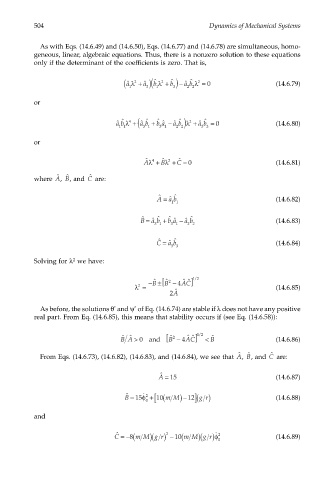Page 523 - Dynamics of Mechanical Systems
P. 523
0593_C14_fm Page 504 Tuesday, May 7, 2002 6:56 AM
504 Dynamics of Mechanical Systems
As with Eqs. (14.6.49) and (14.6.50), Eqs. (14.6.77) and (14.6.78) are simultaneous, homo-
geneous, linear, algebraic equations. Thus, there is a nonzero solution to these equations
only if the determinant of the coefficients is zero. That is,
( ˆ a λ + )( b λ + ) − ˆ a b λ = 0 (14.6.79)
ˆ
ˆ
ˆ
2
2
2
ˆ a
b
1
2 2
3
3
1
or
ˆ a b λ +( ˆ ab + ˆ ˆ a − ˆ ab λ ) 2 + ˆ ab =
ˆ
ˆ
ˆ
ˆ
4
11 31 b 3 1 2 2 33 0 (14.6.80)
or
ˆ
ˆ
Aλ + Bλ + C = 0 (14.6.81)
ˆ 2
4
ˆ
ˆ
ˆ
A B
C
where , , and are:
ˆ
A = ˆ a b ˆ (14.6.82)
11
ˆ
ˆ
B = ˆ a b + b ˆ ˆ a − ˆ a b ˆ (14.6.83)
31 3 1 2 2
C = ˆ a b ˆ (14.6.84)
ˆ
33
2
Solving for λ we have:
4 ]
/
ˆˆ
ˆ
B
λ = −±[B 2 ˆ − AC 12 (14.6.85)
2
ˆ
2A
*
*
As before, the solutions θ and ψ of Eq. (14.6.74) are stable if λ does not have any positive
real part. From Eq. (14.6.85), this means that stability occurs if (see Eq. (14.6.58)):
ˆ ˆ
ˆˆ
ˆ 2
BA > 0 and [ B − 4 AC] / 12 < B ˆ (14.6.86)
ˆ
ˆ
ˆ
From Eqs. (14.6.73), (14.6.82), (14.6.83), and (14.6.84), we see that , , and are:
A B
C
ˆ
A = 15 (14.6.87)
ˆ
B = 15φ ˙ 2 + 10 ( [ m M) − 12 ]( g r) (14.6.88)
0
and
)(
)(
2
ˆ
φ
˙ 2
C =− ( 8 m Mg r) − ( m Mg r) 0 (14.6.89)
10

